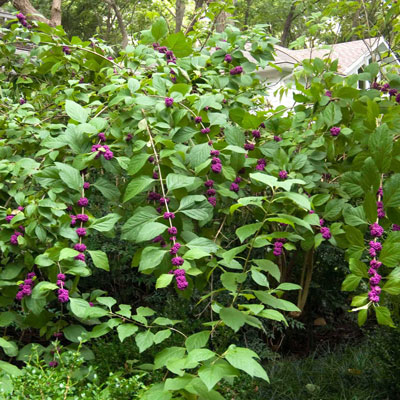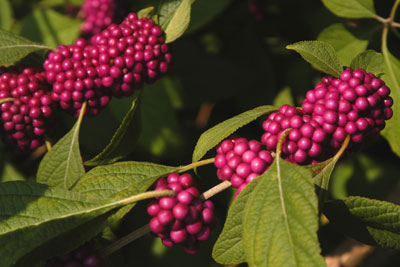Plant of the Week: September 14, 2017
I grew up with this plant all around me. That was in the post oak forests around College Station. I just figured, since it was maroon, that that was where it was supposed to grow.
But this plant has become somewhat more mainstream since then. It’s not an everyday landscaping shrub, but it probably wouldn’t be able to stand up to all the conditions we would throw at it anyway.

Photo: American beautyberries in the Sperry backyard are favorites each autumn.
I’ve grown American beautyberry in my landscape for 40 years. I’ve often described it as a mix between a shrub (which it truly is) and some type of robust perennial plant that never does fill in quite enough to look like a real shrub in my garden. Its mulberry-like leaves are quite large for a fairly short shrub (grows to 4 to 6 feet tall and wide), and it doesn’t branch freely.
I use American beautyberry more as a specimen plant, similar to how I might use a single clump of medium-sized ornamental grass. I would not want to use a row of beautyberries and count on them as a screen. Oh, and that’s also because they’re bare in the winter. Leaves drop in the fall, and the fruit clusters have long since been harvested by the birds.

Photo: Could two branches possibly hold any more berries? It’s as if God has a glue gun!
Field notes from the expert on beauty…
(It’s OK to chuckle right now.)
Here are my own quick observations on growing American beautyberry in Texas home landscapes.
• Morning sun, afternoon shade.
• Moist, highly organic planting soil, preferably deep.
• This plant wilts rapidly when dry. You must make provision for regular irrigation. Not for xeriphytic gardens.
• Its flowers are almost unnoticeable. That’s crazy, as showy as the fruit clusters will be.
• White-fruiting forms and other species with darker fruit are available, but they are not nearly as showy as the native species.
• Fruit clusters are colorful in September and October, but birds harvest the fruit long before winter. I have not had an issue with volunteer (bird-planted) seedlings anywhere in our gardens.
• The Lady Bird Johnson National Wildflower Center in Austin reports this plant’s foliage to be a favorite food of white tail deer. Sorry to break your heart if you have deer in your vicinity.
• American beautyberries are usually more available in spring than in fall. Call ahead and talk to your favorite nursery about whether they have, or will have, this lovely native Texan.
